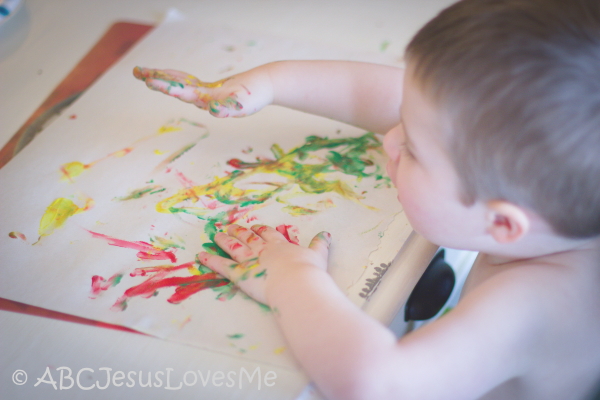 image by becky
image by becky- Discuss with your child what part of the body we use for hearing. Talk about the different sounds that you hear right now. If the weather is nice, sit outside and listen to the sounds around you.
- "Scrunch Paper Collage" - Give the children different items to scrunch up and glue to a piece of cardboard or use to paint. Example items: tissue paper, Kleenex, writing paper, wax paper, foil, construction paper. ( Idea from Tripod )
- March to various beats of a drum. Beat a drum slowly and then fast. Have your child move according to the beat. When the drum stops, instruct the child to freeze.
- Discuss your different voices: whisper (library voice), talking (inside voice), yelling (outside voice), singing, humming. Then discuss opposites using musical instruments - high/low, loud/soft.
- Have the child sit in the middle of the room blindfolded. Make sounds around the room. Have the child figure out where the sound is coming from and what the sound is. This is an activity that could be done while an adult is fixing a meal.
- 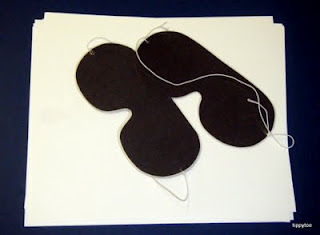
- Talk with your child about the function of her eyes. Ask her to identify the job of her eyes. Explain that most people have eyes. Eyes are different colors and different shapes, but the function of the eyes is just the same.
- Collect several items and place them in front of you. Blindfold the child's eyes and then remove one of the objects. After removing the blindfold, have the child decide which item is missing. Start with a few items and gradually increase the difficulty. ( Idea from Tripod )
- Seated on the floor, blindfold your child. Place four or five similar objects in front of him. Ask for a particular object. Allow the child to feel the objects. Discuss that some people cannot see, and that we should be thankful for our eyesight.
- Play Pin the Tail on the Donkey
- Discuss: What part of our body do we use to smell? Talk about the nose and the job it performs. Also discuss how animals use their noses to find food. (Idea from Tripod)
- Using different items in your refrigerator, pantry, and bathroom, discuss the various smells using words like sour, sweet, etc. Have your child close her eyes or use a blindfold to guess the item that she smells. Example items: lemon juice, milk, applesauce, rubbing alcohol, mouthwash.
- 
Place a squirt of shaving cream on a plate. Spread it out. Add a few drops of food coloring. Using a craft stick, drag the color through the shaving cream to make a swirled design (not too much or the colors will simply mix). Place a piece of paper on top of the shaving cream and gently press. Peel up the paper and scrap the excess shaving cream off the paper with a craft stick. Let dry.
- 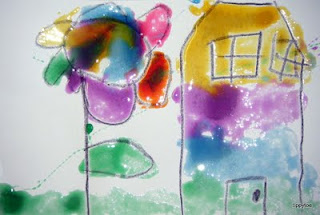
- What part of the body do we use to taste things? Discuss the mouth and the tongue.
- Using different foods in your refrigerator and pantry, taste and discuss how some items don’t taste very good by themselves but how each is very important when making cookies, bread, casseroles, etc. Example items: flour, lemon juice, sugar, salad dressing. (Idea from Let's Learn About Magnificent Me)
- Draw letters and numbers on a cookie sheet using pudding.
- Have your child close their eyes or use a blindfold and guess what they are eating without looking.
- Using the same main ingredient, eat several different things and discuss the differences - applesauce, apple butter, dried apples, apple pie, apple cake, etc. Also eat different varieties of food - grapes, bread products, apples. (Idea from Let's Learn About Magnificent Me)
- This is a good time to discuss with your child that there are things that are okay to eat and things that are not okay. It is also important to ask Mommy or Daddy for permission to eat anything given to you by a stranger.
-  Read Food for Thought - Learn about shapes, colors, numbers, opposites and letters all through amazing and fun food creations.
Read Food for Thought - Learn about shapes, colors, numbers, opposites and letters all through amazing and fun food creations.
- 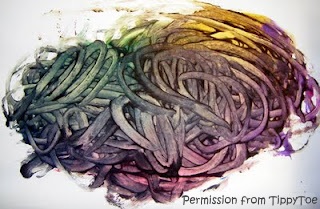
- Place various household items in a bag or box. With eyes closed or using a blindfold, have your child feel and identify each item. Example items: toothbrush, remote control, crayon, toy car.
- 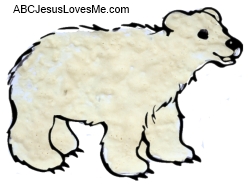 Create a Puffy Polar Bear
Create a Puffy Polar Bear
Print the Polar Bear printable.
Mix: 1/2 cup flour, 2 tsp baking powder, 2 tsp salt, and enough water to make the mixture into a paste.
Place the mixture in a ziptop bag and mix ingredients. Cut off the corner to pipe the mixture onto the polar bear.
Once the polar bear is covered, dab the mixture with your finger to make the mixture look like fur.
Place the paper in the microwave for 20-30 seconds at a time until the mixture has risen and is fully baked.
Discuss how the baking powder forms air pockets in the mixture causing it to puff up.
(You can also do this activity with shaving cream - without microwaving.)
- Fill balloons with various household items and tie off. Have the child figure out the item inside the balloon by feeling it. Suggested items: water, sugar, rice, beans, toothpaste, noodles. (Original Source Unknown)
- Rub different clothing in a closet. Discuss the feeling (i.e. coarse, soft, smooth).
- In a large container, place rice, lima beans, and/or other dried foods to play in like you would a sandbox. This is an excellent sensory activity that can be done inside. It is especially nice when the weather is not conducive to being outside.
- My Favorite Food Collage
Give your child a paper plate or draw a circle on a piece of paper. Allow the child to look through old magazines or grocery ads and cut out pictures of favorite foods to glue on the plate.
- Using different foods in your refrigerator and pantry, taste and discuss how some items don’t taste very good by themselves but how each are very important when making cookies, bread, casseroles, etc. Example items: flour, lemon juice, sugar, salad dressing.
- Draw letters and numbers on a cookie sheet using pudding.
- Using the same main ingredient, eat several different things and discuss the differences - applesauce, apple butter, dried apples, apple pie, apple cake, etc. Also eat different varieties of food - grapes, bread products, apples. (Idea from Let's Learn About Magnificent Me)
- This is a good time to discuss with your child that there are things that are okay to eat and things that are not okay. It is also important to ask Mommy or Daddy for permission to eat anything given to you by a stranger.
-  Read any Touch and Feel Books.
Read any Touch and Feel Books.
- Read:  The Very Hungry Caterpillar - Read this book to discuss taste and the days of the week.
The Very Hungry Caterpillar - Read this book to discuss taste and the days of the week.
- Discuss with your child what part of the body we use for hearing. Talk about the different sounds that you hear right now. If the weather is nice, sit outside and listen to the sounds around you.
- "Scrunch Paper Collage" - Give the children different items to scrunch up and glue to a piece of cardboard or use to paint. Example items: tissue paper, Kleenex, writing paper, wax paper, foil, construction paper. ( Idea from Tripod )
- March to various beats of a drum. Beat a drum slowly and then fast. Have your child move according to the beat. When the drum stops, instruct the child to freeze.
- Discuss your different voices: whisper (library voice), talking (inside voice), yelling (outside voice), singing, humming. Then discuss opposites using musical instruments - high/low, loud/soft.
- Have the child sit in the middle of the room blindfolded. Make sounds around the room. Have the child figure out where the sound is coming from and what the sound is. This is an activity that could be done while an adult is fixing a meal.
- 
- Talk with your child about the function of her eyes. Ask her to identify the job of her eyes. Explain that most people have eyes. Eyes are different colors and different shapes, but the function of the eyes is just the same.
- Collect several items and place them in front of you. Blindfold the child's eyes and then remove one of the objects. After removing the blindfold, have the child decide which item is missing. Start with a few items and gradually increase the difficulty. ( Idea from Tripod )
- Seated on the floor, blindfold your child. Place four or five similar objects in front of him. Ask for a particular object. Allow the child to feel the objects. Discuss that some people cannot see, and that we should be thankful for our eyesight.
- Play Pin the Tail on the Donkey
- 
- Talk with your child about the function of her eyes. Ask her to identify the job of her eyes. Explain that most people have eyes. Eyes are different colors and different shapes, but the function of the eyes is just the same.
- Collect several items and place them in front of you. Blindfold the child's eyes and then remove one of the objects. After removing the blindfold, have the child decide which item is missing. Start with a few items and gradually increase the difficulty. ( Idea from Tripod )
- Seated on the floor, blindfold your child. Place four or five similar objects in front of him. Ask for a particular object. Allow the child to feel the objects. Discuss that some people cannot see, and that we should be thankful for our eyesight.
- Play Pin the Tail on the Donkey
- Discuss: What part of our body do we use to smell? Talk about the nose and the job it performs. Also discuss how animals use their noses to find food. (Idea from Tripod)
- Using different items in your refrigerator, pantry, and bathroom, discuss the various smells using words like sour, sweet, etc. Have your child close her eyes or use a blindfold to guess the item that she smells. Example items: lemon juice, milk, applesauce, rubbing alcohol, mouthwash.
- 
Place a squirt of shaving cream on a plate. Spread it out. Add a few drops of food coloring. Using a craft stick, drag the color through the shaving cream to make a swirled design (not too much or the colors will simply mix). Place a piece of paper on top of the shaving cream and gently press. Peel up the paper and scrap the excess shaving cream off the paper with a craft stick. Let dry.
- 
- What part of the body do we use to taste things? Discuss the mouth and the tongue.
- Using different foods in your refrigerator and pantry, taste and discuss how some items don’t taste very good by themselves but how each is very important when making cookies, bread, casseroles, etc. Example items: flour, lemon juice, sugar, salad dressing. (Idea from Let's Learn About Magnificent Me)
- Draw letters and numbers on a cookie sheet using pudding.
- Have your child close their eyes or use a blindfold and guess what they are eating without looking.
- Using the same main ingredient, eat several different things and discuss the differences - applesauce, apple butter, dried apples, apple pie, apple cake, etc. Also eat different varieties of food - grapes, bread products, apples. (Idea from Let's Learn About Magnificent Me)
- This is a good time to discuss with your child that there are things that are okay to eat and things that are not okay. It is also important to ask Mommy or Daddy for permission to eat anything given to you by a stranger.
-  Read Food for Thought - Learn about shapes, colors, numbers, opposites and letters all through amazing and fun food creations.
Read Food for Thought - Learn about shapes, colors, numbers, opposites and letters all through amazing and fun food creations.
- 
- Place various household items in a bag or box. With eyes closed or using a blindfold, have your child feel and identify each item. Example items: toothbrush, remote control, crayon, toy car.
-  Create a Puffy Polar Bear
Create a Puffy Polar Bear
Print the Polar Bear printable.
Mix: 1/2 cup flour, 2 tsp baking powder, 2 tsp salt, and enough water to make the mixture into a paste.
Place the mixture in a ziptop bag and mix ingredients. Cut off the corner to pipe the mixture onto the polar bear.
Once the polar bear is covered, dab the mixture with your finger to make the mixture look like fur.
Place the paper in the microwave for 20-30 seconds at a time until the mixture has risen and is fully baked.
Discuss how the baking powder forms air pockets in the mixture causing it to puff up.
(You can also do this activity with shaving cream - without microwaving.)
- Fill balloons with various household items and tie off. Have the child figure out the item inside the balloon by feeling it. Suggested items: water, sugar, rice, beans, toothpaste, noodles. (Original Source Unknown)
- Rub different clothing in a closet. Discuss the feeling (i.e. coarse, soft, smooth).
- In a large container, place rice, lima beans, and/or other dried foods to play in like you would a sandbox. This is an excellent sensory activity that can be done inside. It is especially nice when the weather is not conducive to being outside.
- My Favorite Food Collage
Give your child a paper plate or draw a circle on a piece of paper. Allow the child to look through old magazines or grocery ads and cut out pictures of favorite foods to glue on the plate.
- Using different foods in your refrigerator and pantry, taste and discuss how some items don’t taste very good by themselves but how each are very important when making cookies, bread, casseroles, etc. Example items: flour, lemon juice, sugar, salad dressing.
- Draw letters and numbers on a cookie sheet using pudding.
- Using the same main ingredient, eat several different things and discuss the differences - applesauce, apple butter, dried apples, apple pie, apple cake, etc. Also eat different varieties of food - grapes, bread products, apples. (Idea from Let's Learn About Magnificent Me)
- This is a good time to discuss with your child that there are things that are okay to eat and things that are not okay. It is also important to ask Mommy or Daddy for permission to eat anything given to you by a stranger.
-  Read any Touch and Feel Books.
Read any Touch and Feel Books.
- Read:  The Very Hungry Caterpillar - Read this book to discuss taste and the days of the week.
The Very Hungry Caterpillar - Read this book to discuss taste and the days of the week.
- 
- Place various household items in a bag or box. With eyes closed or using a blindfold, have your child feel and identify each item. Example items: toothbrush, remote control, crayon, toy car.
-  Create a Puffy Polar Bear
Create a Puffy Polar Bear
Print the Polar Bear printable.
Mix: 1/2 cup flour, 2 tsp baking powder, 2 tsp salt, and enough water to make the mixture into a paste.
Place the mixture in a ziptop bag and mix ingredients. Cut off the corner to pipe the mixture onto the polar bear.
Once the polar bear is covered, dab the mixture with your finger to make the mixture look like fur.
Place the paper in the microwave for 20-30 seconds at a time until the mixture has risen and is fully baked.
Discuss how the baking powder forms air pockets in the mixture causing it to puff up.
(You can also do this activity with shaving cream - without microwaving.)
- Fill balloons with various household items and tie off. Have the child figure out the item inside the balloon by feeling it. Suggested items: water, sugar, rice, beans, toothpaste, noodles. (Original Source Unknown)
- Rub different clothing in a closet. Discuss the feeling (i.e. coarse, soft, smooth).
- In a large container, place rice, lima beans, and/or other dried foods to play in like you would a sandbox. This is an excellent sensory activity that can be done inside. It is especially nice when the weather is not conducive to being outside.
- My Favorite Food Collage
Give your child a paper plate or draw a circle on a piece of paper. Allow the child to look through old magazines or grocery ads and cut out pictures of favorite foods to glue on the plate.
- Using different foods in your refrigerator and pantry, taste and discuss how some items don’t taste very good by themselves but how each are very important when making cookies, bread, casseroles, etc. Example items: flour, lemon juice, sugar, salad dressing.
- Draw letters and numbers on a cookie sheet using pudding.
- Using the same main ingredient, eat several different things and discuss the differences - applesauce, apple butter, dried apples, apple pie, apple cake, etc. Also eat different varieties of food - grapes, bread products, apples. (Idea from Let's Learn About Magnificent Me)
- This is a good time to discuss with your child that there are things that are okay to eat and things that are not okay. It is also important to ask Mommy or Daddy for permission to eat anything given to you by a stranger.
-  Read any Touch and Feel Books.
Read any Touch and Feel Books.
- Read:  The Very Hungry Caterpillar - Read this book to discuss taste and the days of the week.
The Very Hungry Caterpillar - Read this book to discuss taste and the days of the week.
This page may contain affiliate links. Please read our disclosure policy.